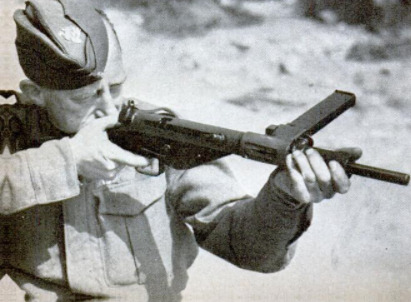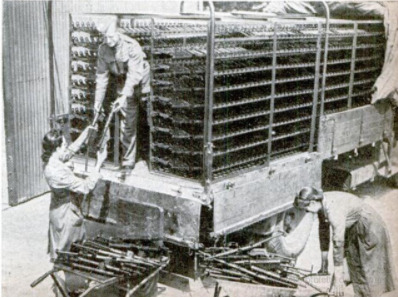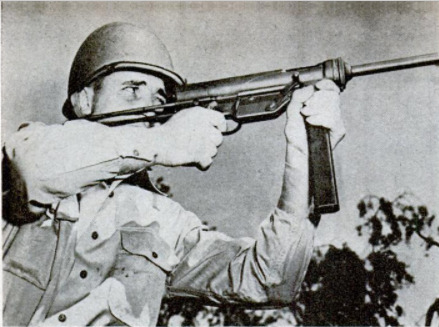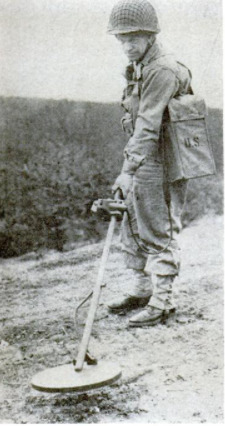-
Title (Dublin Core)
-
Equipment for French resistance
-
Article Title and/or Image Caption (Dublin Core)
-
Title: Sten gun to be forerunner for invasion
-
Subtitle: Thousands will be parachuted to guerrillas behind Axis line
-
extracted text (Extract Text)
-
A HUNK of pipe—with a door spring in
it,” is the apt description given the new
British Sten submachine gun, which soon
may be plummeting from the skies over
Europe into the eager arms of Frenchmen,
Poles, Czechs, and others who want to fight
their way out of slavery.
Faced with the problem of producing in
quantities a gun simple enough to be oper-
ated by the untrained peasants who will be-
come Europe's new guerrilla fighters,
British ordnance experts threw out
all previous notions of armament
making and came up with this gun
(P.S.M., Sept. '42, p. 65; Jan. 43,
p. 131) that made orthodox military
thinkers gasp. But even the skeptics
gave in when they saw the ugly
duckling in action. Capable of firing
500 to 550 rounds a minute, this
sturdy, six-pound package of dyna-
mite can be operated by a child. It
doesn’t even require oiling, It has
only two machined parts, the bolt and
the barrel; every other part is the
cheapest kind of stamping. Firing is
accurate up to 100 yards.
‘What's more, engineers thoughtfully
designed the Sten to fire all types of
9-mm. Parabellum ammunition and
most other shells of the same caliber.
Guerrilla fighters will be thankful for
this foresight when the “big push”
comes and they begin to take over
enemy ammunition caches, for they will
be able to load Sten magazines with
cartridges made for German Schmeisser
and Bergmann submachine guns, the
Italian Beretta machine carbine, and a
wide range of Axis service rifles and
carbines.
SUBMACHINE GUN.
Known as the M-3, this |
handy 45-caliber weapon, |
designed by the Army for |
parachute troops, spits out
450 rounds per minute |
with good accuracy at |
short range. Almost toy- |
like in appearance, the |
gun weighs nine pounds, |
and when collapsed will
fit into a brief case. It is
made mostly of stamped
parts, and can be mass- |
produced for only $20.
Amazingly rugged, the |
gun is said to be compara-
tively unaffected even by
immersion in salt water.
THIS PORTABLE PRESSURE CHAMBER shows which of
our airmen can fly high. It is used by a U.S. Air Pro-
visional Medical School in England to test flyers’ physical
condition and their reaction to high altitudes. The flyer
enters the chamber, an airtight door is closed, and the air
is slowly pumped out to simulate high-altitude conditions.
The men are tested with and without oxygen masks, to
ascertain their reactions at various degrees of pressure.
CLEARING A PATH through
mine fields is a ticklish job for
the combat engineers, even
with this hypersensitive mine
detector. Powered by batteries,
the instrument is an adapta-
tion of the metal finder used
by prospectors. As it senses
buried metal, a buzz is trans-
mitted to the operator's ear-
phones. The louder the buzz,
the closer the mine, and the
engineer marks the spot with
pegs as a guide to sappers who
will be sent to remove the
mine from the path of advance.
TORPEDOED. Sea-
‘men disembarking in
a Canadian seaport
on the Atlantic coast
enjoy having them-
selves ferried to
shore through the
gaping hole left in
the bow of a freight-
er by an enemy tor-
pedo. The hardy sea-
men have a grim
name for the trip.
They call it the
“Scenic Route.” Wa-
ter taxis shuttling
back and forth
across the harbor
find that the novel
passageway, which
is large enough to
accommodate a fair-
sized dingy, provides
them with a conven-
jent short cut. At-
tacked by a subma-
rine in the Atlantic,
. the vessel, as can be
seen from the pho-
tograph, was solidly
hit. Tnstead of sink-
ing, however, the
stout vessel righted
itself and the crew
brought it to port
without aid.
SHIP FENDERS,
designed to protect
vessels from dam-
age when they re-
fuel or take on car-
goes at sea, are
now being made of
fir from the Pacific
Northwest, instead
of orental wicker,
which is no longer
available. The fir
poles are first cut
to length, then
driven into place in
a wooden frame, A
woven network of
rope holds them
fast. Fenders are
hung over a ship's
side when it goes
alongside another
vessel to transfer
fuel or cargo, to
prevent their scrap-
ing.
-
Contributor (Dublin Core)
-
B. G. Seielstad (Illustrator)
-
Language (Dublin Core)
-
eng
-
Date Issued (Dublin Core)
-
1943-09
-
pages (Bibliographic Ontology)
-
54-57
-
Rights (Dublin Core)
-
Public Domain (Google Digitized)
-
References (Dublin Core)
-
Sten
-
Archived by (Dublin Core)
-
Matteo Ridolfi
-
Marco Bortolami (editor)
-
Spatial Coverage (Dublin Core)
-
France
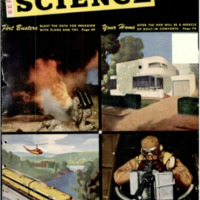 Popular Science Monthly, v. 143, n. 3, 1943
Popular Science Monthly, v. 143, n. 3, 1943

